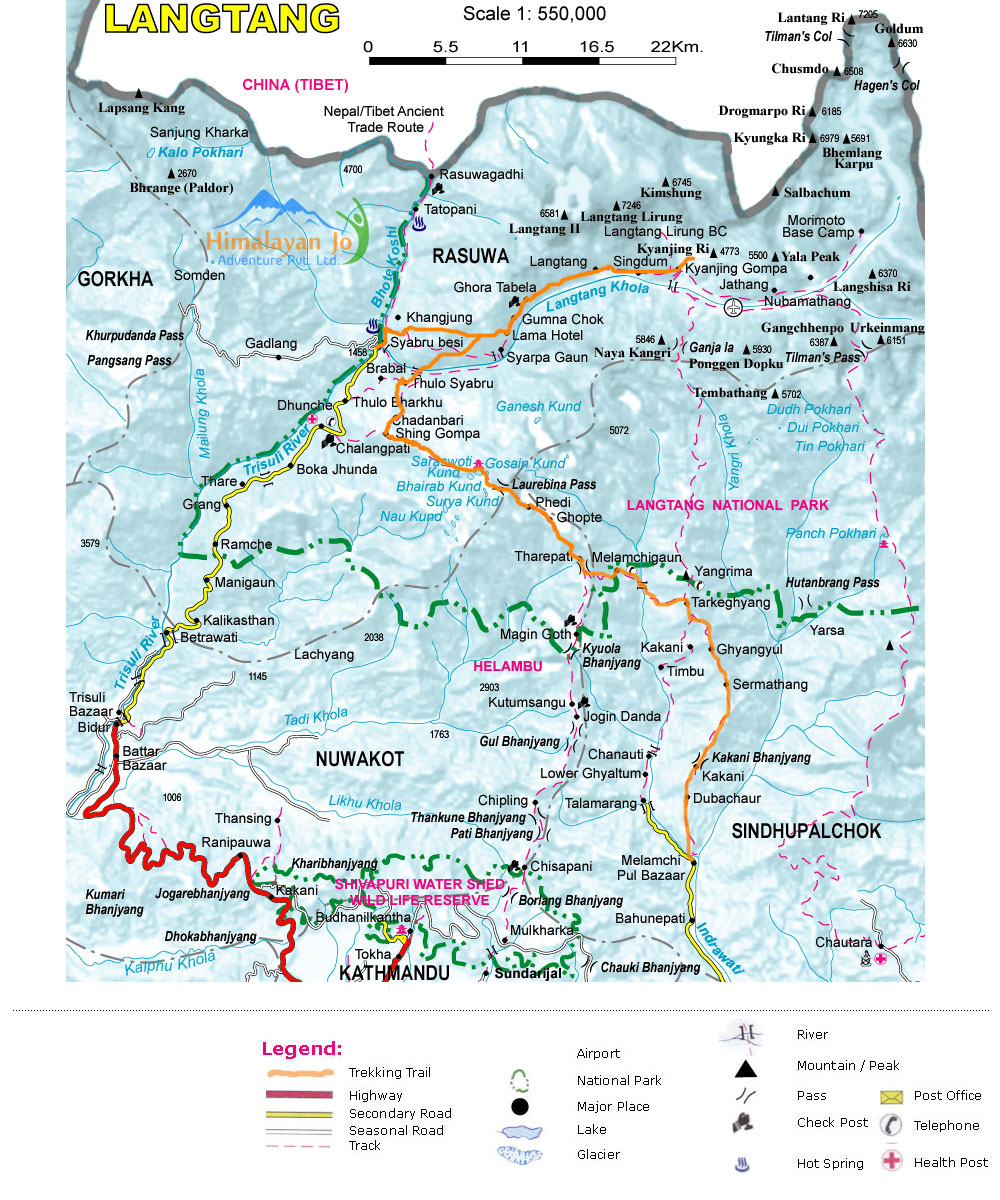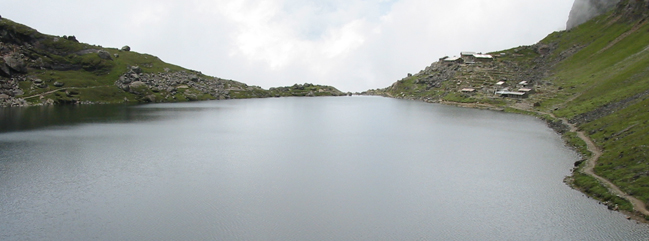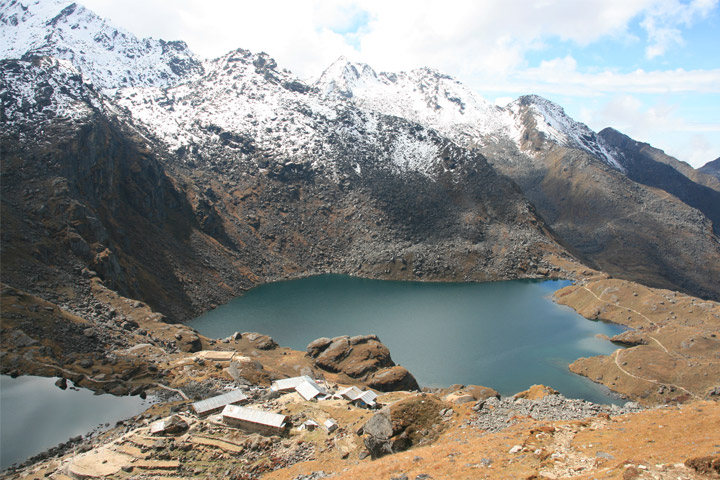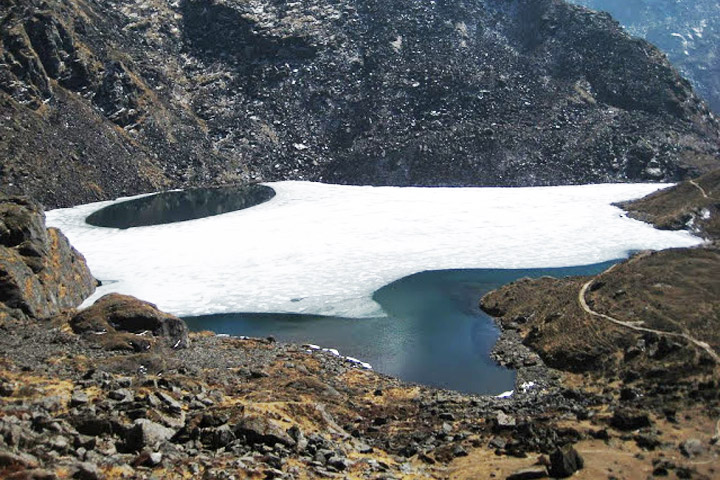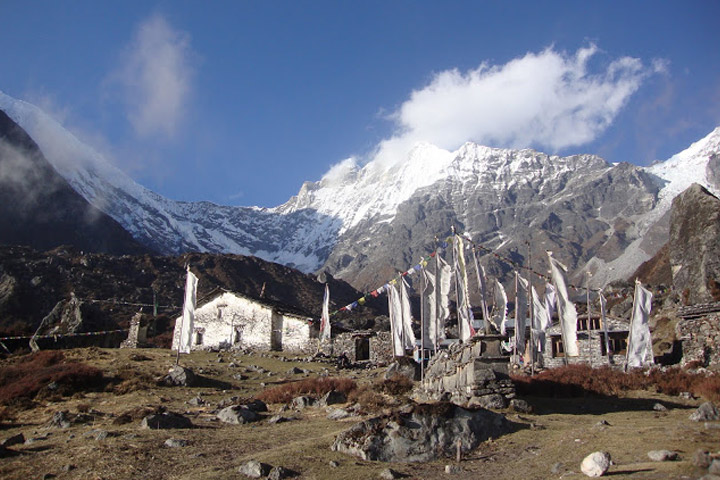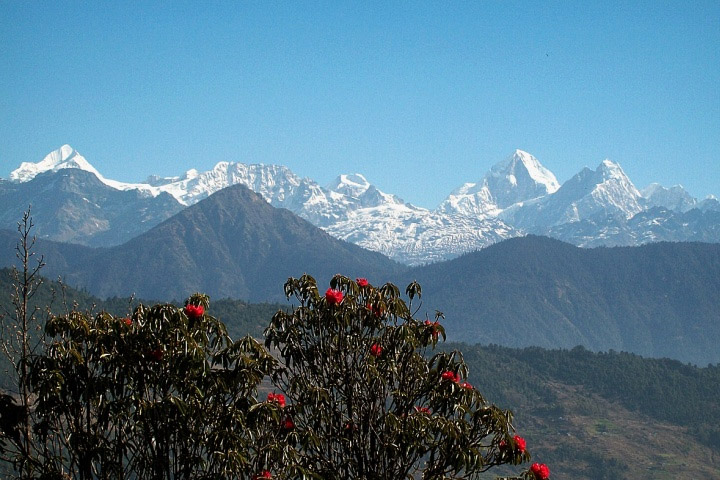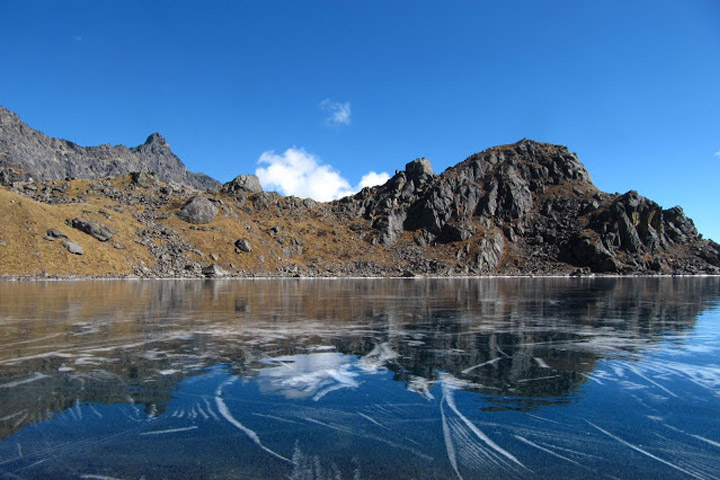Langtang Gosainkunda Trekking is situated close to the Tibetan border and remote valley enclosed by snow-capped mountains that ends in the peak of Langtang Lirung (7246m).
The trekking begins Syabru Bensi, which is seven or eight hour drive from Kathmandu, then we trek through larch and rhododendron forests which is rich in wild flowers and birds, explore the head of the valley getting close to the glacier system. Finally we climb on the nearby peak for amazing mountain views. Subsequently, from the place, we ascend up and pass the holy lake Gosaikunda and enter Helambu via the Laurebina pass (4610m). In between we can enjoy with the stunning views of Mt. Manaslu, Ganesh Himal and the Annapurna massif. During the trekking, we pass through the sub-tropical jungle, then a dense forest of oak, birch and pine, and the valley, which is of alpine meadows and yak pastures. When we descend from the upper Langtang Valley, we retrace the route back to Syabru village than continue trek to holy Gosainkund lake. After crossing Gosainkund pass (4610m), trail continues and leads to the Helambu valley then we make almost a circle going through Tharapati, Tarkeghyang, Sermathang to Melamchi pul bazaar then by private vehicle or by bus, we return back to Kathmandu.
The Langtang forests are also well known for their wildlife, including red pandas, Himalayan black bear, wild boar and langur monkeys. Similarly, you also can sight monkeys between Syabru and Ghora Tabela. The views of snow capped mountains-Langtang Lirung, Pemthang Ri, Langshisha Ri, Dorje Lakpa, and Kangchenpo, Tilman’s fluted peak seem really awesome. Gosainkunda trekking is one of the areas that Outfitter Nepal’s guests love to visit.
Day 01. Arrival at Kathmandu
Arrive at Kathmandu airport (1345meters). You will be met by our representative and transfer to hotel and a short brief about the trekking after refreshment.
Day 02. Sightseeing at Kathmandu
Kathmandu Valley Sightseeing Tour including Kathmandu Durbar Square, Patan Durbar Square, Monkey Temple, Pashupatinath Temple and Baudhanath Stupa.
Day 03. Drive from Kathmandu to Syabru Besi:
It takes about nine hours. You head north out of Kathmandu driving through scenic foothills and ridgeline vistas to Syabru Besi passing through Dhunche. While passing along the road at the bank of Trishuli River you catch a glimpse of Ganesh Himal, terraces and green hills. As you pass through Dhunche you feel as if you are heading towards deep land. At the same time, you notice that the road is still under construction.
Day 04. Trek from Syabru Besi (1600m.) to Lama Hotel (2470m.):
It takes about five and half hours. The first part of the trail crosses through Bhote Koshi and follows the Langtang Khola. The trail is gradually ascent up to Bamboo passing through Landslide. Afterwards, you trek ascends gently to Rimche (2400m.) through Bamboo (1960m.) which lies at the bank of Langtang Khola. You can have lunch at this place if you like. And at the end your trail is level to the Lama Hotel. En route you could see red pandas, monkey and bear if you are lucky.
Day 05. Trek from Lama Hotel to Langtang village (3430m.):
It takes about six hours. As you continue climbing there are occasional glimpses of Langtang Lirung between the trees. At Ghora Tabela (3000m), the trail emerges from the forest. Once there was a Tibetan resettlement project here, but now it is a Nepalese army post though it has no permanent inhabitants. The trail continues to climb gently and the valley widens, passing a few temporary settlements used by herders who bring their livestock to graze in the high pastures during the summer months. There is a monastery, which you can visit shortly before arriving at the village of Langtang, the headquarters of the Langtang National Park. The houses of Langtang and its neighboring villages are of the flat-roofed Tibetan style, surrounded by stone walls enclosing fields of buckwheat, potatoes, wheat, turnips and barley.
Day 06. Trek from Langtang Village to Kyangjin (3870m.):
It takes about three hours. The trail climbs gradually through small villages and yak pastures as the valley opens out further and the views become more extensive. After crossing several small streams and moraines, the trail reaches the settlement at Kyangjin. Here there is a small monastery and a government-operated cheese factory. You will arrive at Kyangjin by lunch time allowing time to acclimatize and explore the area. It is a dramatic setting, with snow-covered peaks surrounding you in all directions such as Langtang Lirung, Ganjala peak, Tserko ri, Langsisa ri and many others.
Day 07. Rest day at Kyangjin Gompa and excursion around:
Today is to rest and explore the area. You can visit the monastery and the cheese factory, walk up the moraine to see the spectacular ice faces and tumbling glaciers of Langtang Lirung or ascend Kyangjin Ri (4350m), directly behind the village, for a breath-taking panorama of the Langtang peaks.
Day 08. Trek from Kyangjin Gompa to Lama Hotel (2470m.):
It takes about six hours. From Kyangjin you retrace your route, following the Langtang Khola to Langtang village and on to Ghora Tabela. After lunch, you continue the steep descent to Lama Hotel.
Day 09. Trek from Lama Hotel (2470m.) to Thulo Syabru (2260m.):
It takes about five hours. The beginning of the trails is gently descent up to Landslide and then goes steeply up to Thulo Syabru. En route you could see red pandas, monkeys and various species of birds. Thulo Syabru is one of the wonderful villages. From where you can enjoy the amazing land feature and the magnificent nature with splendid views of Ganesh Himal (7110m.), Langtang Himal and its ranges.
Day 10. Trek from Thulo Syabru to Sing Gompa (Chandan Bari) (3250m.):
It takes about four and half hours. The trails from Thulo Syabru to Foprang Danda (3200m.) follows steeply ascent path passing through Dursagang (2660m.) along with the view of Langtang Himal, Ganesh Himal, Tibetan Mountain and oak, Hemlock, firs forests. Now the path gently ascends for some distance and then follows flat level to Sing Gompa. There is a well-managed local cheese factory and a Buddhist Monastery. If time permits, you can relax at place which is recommended for having excursion in and around Sing Gompa as it provides panoramic view, exhilarating nature and a walk in and around Yak Cheese factory.
Day 11. Trek from Sing Gompa to Gosaikunda (4361m.) via Lauribinayak La (3920m.):
It takes about five and half hours. The first part of the trails emerges gently ascent up to Lauribinayak and the top of Lauribinayak gives you an exotic feeling. Then the trails steeply ascend all the way to Gosaikunda. You follow a rugged trail with dramatic views; to the west Himal chuli (7893m) Manaslu range (8156mm), Ganesh Himal range (7406m), Tibetan peaks and Langtang Lirung. On a clear day, even the Annapurna range can be seen rising up behind and to the north across the valley is Langtang Lirung. You pass a few huts in the high pasture of Laurebinayak, cross a small ridge and have your first views of the holy lakes. There are about a dozen lakes in the Gosainkunda Basin, the main three being Saraswatikunda, Bhairabkunda, and Gosainkunda. According to thelegend, Gosainkunda was created by Shiva when he pierced a glacier with his trident to obtain water to quench his thirst after having swallowed a poison that threatened to destroy the world.
Day 12. Trek from Gosaikunda to Ghopte via Lauribinayak Pass (4609m):
I take about 7 hours and the trail leaves Gosainkund and climbs through rugged country, past four more small lakes to the Laurebina La (4610m), the highest point of this trek. Keep looking back for spectacular views of Manaslu and the mountains of the Ganesh Himal, as well as the now familiar Langtang Lirung. You then descend steeply to camp near Gopte.
Day 13. Ghopte to Kutumsang (2,600m):
After the wilderness, the trail now joins the other path of Helambu,Today it is a pleasant walk through the alpine forest for an hour, with another where you can have lunch and enjoy views of the snow capped peaks of the Jugal Himalayan range in the east and Ganesh-Manslu in the west. After lunch we follow the trail descending for few hours to Kutumsang for the overnight stop. Kutumsang is a small Sherpa village and the exit and entry point of Langtang national Park.
Day 14. Kutumsang to Chisopani Danda (2,195m):
There is a pleasant walk in the morning passing through a number of rural farm villages, through the village of Gul Bhanjyang and on to Pati Bhanjayang after a 3-4 hours trek. From here, there is a short uphill climb to the overnight stop at Chisopani danda. This is a scenic spot at the top of the hilltop en route to Kathmandu . Chisopani, a scenic viewpoint, offers fantastic views of the Jugal Himal range in the north east and Ganesh Himal-Manaslu and Annapurna range in the west and the surrounding landscapes and valleys down below.
Day 15. Chisopani to Sundarijal (1,380m) drive back to Kathmandu:
Today is the last day of this beautiful journey. In the morning we walk through serene forest and farmlands and on to the top of the ridge of Burlang and Chepu Bhanjyang at 2,438m with its great views of Kathmandu Valley. From here the track descends to Sundarijal (beautiful water) through cool forest with monkeys and fresh streams. This is a popular picnic spot for many Kathmandu people who want to escape from the busy crowded metropolitan life in the city. Another hour descent brings us back to civilization, from where we will drive to Kathmandu.
Day 16. Final Departure
The trip ends, our Airport Representative will drop you to the Kathmandu International Airport for your flight departure from Nepal.
NOTE: The above information is a guide and standard template of what we provide. The trek can be customized at your request to accommodate your specific requirements.
Note : On adventure trips of this type, weather, local politics, transport or a multitude of other factors beyond our control can result in a change of itinerary. It is, however, very unlikely that the itinerary would be substantially altered; if alterations are necessary the leader will decide what is the best alternative, taking into consideration the best interests of the whole group. Where a change does occur, we do everything we can to minimize its effect, but we cannot be responsible for the results of changes or delays.
Q.What type of shape do I need to be in, is this trip for me?
A. Trekking is suitable for average people who are moderately fit, thus no previous experience is required. Some physical fitness programs such as running, swimming, hiking is recommended before you embark on your journey. Persons suffering from a pre-existing medical condition or disease must seek medical advice before considering the trek. Whilst on the trek, it is common to experience some discomfort before being fully acclimatized.
To prepare for a strenuous trek you should begin training at least two to three months before your departure. As a guideline, an hour of aerobic exercise three to four times per week would be considered a minimum requirement. The best preparation is bushwalking involving relatively steep ascents and descents. If you can manage a couple of valley floor to ridgeline ascents per comfortable and able to enjoy the trek to the fullest. They are physically strong, sharp-witted and have an incredibly positive attitude towards a life that we would consider extremely tough. There is something about a trek in the Himalaya that draws you back time and time again. For keen walkers it is a paradise and even avowed non-walkers find that one foot just seems to follow the other, drawn by the appeal of what lies beyond.
Q. Will somebody come to pick me up at the Airport upon my arrival?
A. Yes, our Airport Representative will be there to greet you outside of Terminal Hall, he/she will be displaying an Kiwi Adventures Treks & Expedition sign board. Upon arrival, you will be transferred to your hotel.
Q. What sort of accommodation can I expect in Kathmandu and in trekking?
A. 11 night’s Trekking Guesthouse, 4 nights three/four star hotels in Kathmandu.
We use standard rooms from three/four star hotels in Kathmandu with breakfast included. Along the trekking routes teahouses/Lodges generally provide basic clean facilities with a mattress and a quilt or blanket. We can also offer you sleeping bags if needed (which need to return after the trip) but it is a good idea to always have your own sleeping equipment. We usually provide single and double rooms as well as the occasional dormitory. The dining room is downstairs around a fire. All food will be cooked to order in the little kitchen. You should not enter the kitchen unless asked to do so.
Q. What sort of food can I expect in trekking?
A. In trekking most teahouses (lodges) cook a delicious range of mostly vegetarian fare. Pasta, tuna bakes, noodles, potatoes, eggs, dhal bhat, bread, soups, fresh vegetables (variety depends on the season) and even some desserts like apple pies, pancakes, and some interesting attempts at custard. You will find a lot of garlic on the menu because it assists with acclimatization – eat some every day. In many larger villages you may find some meat on the menu. You can always get hot chocolate, tea, and hot lemon drinks, as well as soft drinks, and treats like chocolate and crisps.
Each day dinner and breakfast are used to take in the same lodge you spend the night. Lunch will be taken on the way to destination.
Q. What sort of transportation you use?
A. Kiwi Adventures Treks & Expeditionn is all about providing you with local insights as well as adventure, with that in mind, where we think you will get more out of your holiday by using different means of transport that is what we do. Using a variety of private transport is an integral part of our Himalaya tours and enhances the experience!
We use private tourist vehicles for sightseeing, city tours and pickups. Depending on the group size we use cars, minibus, van or land cruiser. These small light vehicles are more manoeuvrable and flexible enabling us to take you through the Narrow roads of Nepal. All the vehicles are usually air-conditioned unless we are travelling in cooler areas.
Q. What is the best season for this trekking?
A. Our trekking season extends from mid- September to May. From early September the monsoonal rains decrease. By end of September through to December the weather is usually stable with mild to warm days, cold nights. February, March, April, May, October, November, December are the best time to do trek.
Q. What is the weather & temperature like in trekking?
A. Weather in the mountains is notoriously difficult to predict. At night it is generally cooler the days are generally warm. Winter (January and February) will be bit colder but the days can be quite beautiful and warm if the sun is out. There will be bit of snow during the month of January, February and December. It is also important to make sure that you can stay warm and dry in just about any conditions. Expect the unexpected! The temperature could be as high as 20 deg C to -15 deg C low.
Q. Can I charge my digital camera or other batteries on my trip?
A. These facilities will be available in most of the places in your hotel reception by paying some service charges. Remember to bring your adapters!
Q. Is there any communication while we are on trekking?
A. There are telephones in some villages along the trekking routes from which you can make international calls.
Q. Can I use credit cards in the places visit in trekking?
A. In most cities yes, to some extent, however once you leave those cities behind, all you need is cash.
Q. How much additional money do I need per day?
A. In Kathmandu, you can allocate US$ 10 – 25 for a lunch / dinner. It’s all depends on your spending habits. US$7 to 10 US$ a day will be enough to buy bottles of water, chocolates and few drinks in trekking.
Q. Do I need to tip my guide and porters? How much would that be?
A. This is a difficult thing to gauge. We have seen everything from 20USD to 1000 USD per person for guides and porters. Tipping is not required, but a small way to show your guides and local porters thanks for their help. The level of the tip should reflect the level of personal involvement with your guide.
Q. Is the water OK to drink? Do I need to bring purifying tablets/filter?
A. In most places bottled water is readily available. If you wish to drink normal water, you need to use purifying aid, which you will need to bring with you.
Q. Are the Kiwi Adventures Treks & Expedition staff insured?
A. Our company insures all our trekking staff, including guide, cook, sherpa and porters.
Q. What essential documents do I need to bring with me on tour?
A. *Valid Passport – must be valid for up to 6 months after you return from your tour, keep a separate photocopy.
*Travel insurance, keep a separate photocopy
*Cash and Traveller’s Cheques, keep numbers and proof of purchase separate
*Flight tickets
*Emergency contact numbers for T/C’s, banks, insurance, family contacts.
Q. Can I add extra days to my trekking trip?
A. A hoilday should never be about making it to the final point quickly. Along your trek we can add days at your request with additional costs to cover guides, porters, accommodation and food.
Q. Do you use yaks/porters on the trek or do we carry all of our own gear?
A. Whilst on the trek, our porter will take care of your luggage. All you need to carry is your small day bag for your personal belongings like camera, water bottle, sun cream etc only.
Q. What opportunities will I have for shower along the trek?
A. In major places, we arrange guesthouse with hot shower. And in rest of the places, hotel water in bucket will be provided for shower; it would cost you extra about USD 3-4 per shower.
Q. Do you know about how many total miles the trek is?
A. Total distance of the entire trek is about 75 miles.
Cost Includes
• Airport / Hotel / Airport pick up & drop by private car / van / bus.
• Heli Charter till Ghoda Tabela
• Standard accommodation in four/five star hotel in Kathmandu breakfast included.
• Guided city tour in Kathmandu by car / van / bus.
• Sightseeing/Monuments entrance fees in Kathmandu.
• All your standard Meals (breakfast, lunch and dinner) during the trek.
• Best available Lodges, Guesthouses accommodation during the trek (mainly in twin sharing).
• A local government licensed English speaking Guide during the trek.
• The required number of staff and Porters to carry your luggage during the trek.
• Food, accommodation, salary, insurance, equipment, medicine and transportation for all trekking/tour staff.
• Langtang National Park permits.
• First aid medical kid.
• Surface transfer from and to Kathmandu.
• All our government taxes.
• Official expanse.
Cost Excludes
• Lunch and dinner whilst in Kathmandu.
• Your travel insurance (compulsory).
• International airfare and airport departure tax.
• Nepal entry visa fee (US$ 30 per person) you obtain a visa easily upon your arrival at Tribhuwan International Airport Kathmandu for 60 days from date of issue. You will require 2 passport size photos.
• Alcoholic, hot and cold drinks, laundry.
• Personal trekking Equipments.
• Tips for trekking staff. (Tipping is expected).
• Any others expenses which are not mentioned on Price Includes section.
